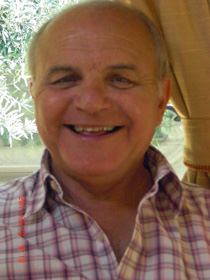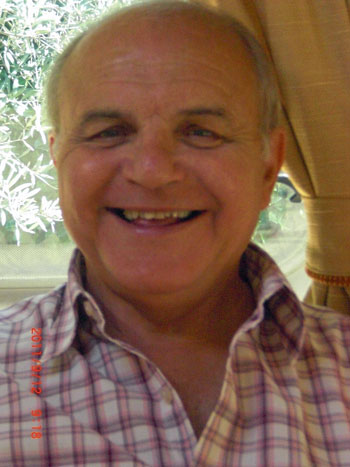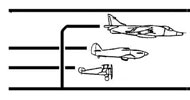

|
|
Name: |
| Gordon Jefferson | |
| Biographical Details: | |
|
Gordon Jefferson was born in 1923. During the war he was in the Fleet Air Arm and joined Hawkers in 1946 as a draughtsman in the Experimental Drawing Office. He worked at Canbury Park Road for five years, getting to know everybody in the Design Department, but in 1951 decided to emigrate to Canada.When this did not work out and he returned to Britain, Sydney Camm offered him another job at Hawkers – this time at Dunsfold. In the 1960s he became Chief Engineering Manager of the Design Department and in 1985 went to America to become Liaison Engineer for British Aerospace at McDonnell Douglas. He retired in 1988.
|
|
|
|
|
Interview Timeline |
|
|
Name: |
Gordon Jefferson |
|
Date of Interview: |
22nd December 2012 |
|
0.00 |
Introduction and interviewee details |
|
0.49 |
Family background – Schooling – At Kingston Technical College – Moved to London in 1935 – training for engineering qualification – joined Fleet Air Arm |
|
4.40 |
Bombing of New Malden during WW2 – job with Kingston Council assessing damage caused by V-1s – area around Portland Avenue much damaged – comparison between bombing in New Malden and Kingston |
|
8.37 |
Description of doodlebug attack – what it was like to come under attack – the trauma that it caused – getting used to being bombed |
|
9.42 |
Joining the local Home Guard – Story of the bomb landing on the embankment of the Hogsmill near the Plough – incendiary bombs |
|
13.00 |
1939 – being in the Home Guard – shooting practice at Bisley |
|
14.00 |
Joining the Fleet Air Arm – training as an Engineering Officer – course at Warrington – friendship with Norman Dimmock – training with the navy was overly academic – practical engineering course at Watford – posted to St Mirrin in Cornwall – posted to Gosport – the end of WW2 – story about a fire at the base – demobbed to go back to industry |
|
23.20 |
Returns to Kingston Technical College – recommended to study aircraft design and sent to Hawkers – joins Experimental Drawing Office after a 3 week course |
|
24.22 |
1946 – Interviewed by Frank Cross at Hawkers – Meets Ralph Hooper – Decided to go to Canada – Story of how Sydney Camm got him a job at Avro in Canada |
|
27.01 |
Moves to Canada – Working at Avro does not work out – awful Canadian aircraft |
|
27.51 |
Sydney Camm offers a job back at Hawkers – In Design Department but not as a draughtsman – goes to Boscome Down – Hawkers did not know what to do with him |
|
29.06 |
Between 1946 – 1952 worked at Canbury Park Road – the two Drawing Offices, Experimental and Production – lack of liaison between the two – The Stress Office – Research and Testing |
|
31.54 |
Frank Cross and Harold Tuffen, numbers one and two in Experimental Drawing – becomes Frank Cross’s P.A. Frank Cross moved sideways after Sydney Cann’s death – moved into planning |
|
38.17 |
Harold Tuffen |
|
39.54 |
Job after return from Canada – Sent to Dunsfold – development of the Hawker Hunter in 1950s – delays on the Hunter – story of fires on Hunters at Dunsfold |
|
43.40 |
Summoned back to Kingston by Sydney Camm – shares office with the librarian, Eveline Coddington – becomes P.A. to Frank Cross after move to Richmond Road |
|
45.06 |
Sydney Camm – first meeting with Camm – Camm’s daily tour around the boards – how Camm enjoyed banter – story of cadets on visit to the factory – relationship with Camm characterised by respect but not fear |
|
50.05 |
How today bullying behaviour is not acceptable in the workplace – bad behaviour of Hawker directors – story of Ministry coming to see directorate and getting a cold reception |
|
53.50 |
Going to meetings in Sydney Camm’s place – story of the £2 million cheque not handed across – relations between Ministry and Design Department were good – relations between government and the company changed after the Hawk contract |
|
56.37 |
Mr. Hollyhock and liaison with the Ministry |
|
57.37 |
How the company worked with government – not involved in the contractual side – change in government attitudes after Hawk contract – change in how minutes of meetings were taken |
|
60.53 |
Sydney Camm and the government – Modifications meetings at Dunsfold – Camm not a ‘meetings person’ – how Camm hated meetings and gave the job to other people |
|
63.23 |
Avros, Roy Chadwick and the Lancaster bomber – Hawker aircraft after the Hurricane were designed by teams – Camm’s era was really the biplane era – Hurricane was really a biplane design |
|
66.00 |
Sydney Camm as a leader of design teams – Camm successful because he generated enormous respect |
|
67.35 |
Roy Chaplin was the softer side of the system – story of driving to Boscombe Down with Chaplin – Chaplin’s favourite expression |
|
72.53 |
Design Office at Claremont during WW2 – moved back to Kingston before GJ joined |
|
73.48 |
First Hawker jets – Sea Fury and P.1040 – Jet development in the Design Office. Age profile of the Drawing Office |
|
76.21 |
Other draughtsmen he remembers – the lofting floor |
|
78.01 |
End |
|
Interview Timeline |
|
|
Name: |
Gordon Jefferson |
|
Date of Interview: |
28th December 2012 |
|
0.00 |
Introduction and interviewee details |
|
0.33 |
The RTO – Resident Technical Officer – what his job entailed – government owned aircraft and any modification had to be done through RTO. Many different RTOs after Camm died |
|
4.05 |
How the modification process worked |
|
5.46 |
From 1970s less trust between government and manufacturer – problems at Preston (BAC) – government wanted to toughen up the relationship |
|
8.00 |
Relations between Hawker Directorate and Government was more abrasive than between the RTO and the Design Dept – there were meetings between the Directorate and the Government on the P.1127 which GJ attended in the place of Sydney Camm |
|
12.30 |
Sydney Camm could be naive in meetings – Story of Modifications meeting at Dunsfold – did not hear of the awarding of the Hawk contract through official channels |
|
17.20 |
Sir John Lidbury and Eric Rubython – Lidbury and how he dealt with company finances – anecdote about Lidbury and GJ’s car – Lidbury’s positive attitude to those who were doing a good job |
|
21.48 |
Anecdote about asking Eric Rubython’s permission to paint Neville Duke’s car red – why it was a good idea in Hawkers to do things ‘on the quiet’ |
|
25.46 |
Story about John Lidbury’s farm near Dunsfold |
|
28.30 |
The World Air Speed Record in the Hunter 1953 – GJ’s time at Dunsfold – summoned back to Kingston by Sydney Camm |
|
30.51 |
Mood in the company in 1953 after the Hunter record |
|
31.55 |
Story of John Crampton flying Canberras – the Official Secrets Act |
|
34.21 |
Never met Tom Sopwith – but Sopwith’s son used to drive at Dunsfold |
|
35.35 |
The reverse side of John Crampton – how he would take off in his boat |
|
37.46 |
Tropical trials in Aden, Bahrain and Khartoum |
|
39.24 |
Anecdote about being locked up at Cairo Airport after Suez Crisis |
|
42.50 |
Anecdote about MIG-15 photographs |
|
43.55 |
Story of Canberra tail plane damaged by bird strikes |
|
46.48 |
Flying in a Hastings to Bahrain |
|
47.43 |
Purpose of tropical trials was to test hot weather equipment and how the aircraft responded in extreme conditions |
|
50.00 |
Hawker Hunters sold all over the world – arctic testing was done in Canada |
|
51.17 |
Tropical trials of the Hunter from 1954 to 1957 – Ralph Hooper beginning work on the P.1127 |
|
53.07 |
Sydney Camm and the P.1082 – ‘handsome is as handsome does’ |
|
54.29 |
1957 Defence White Paper – Camm did not get to build his supersonic fighter |
|
57.56 |
Politicians know very little about defence or engineering |
|
59.14 |
Hunter development finishing in late 1950s – struggle to get interest in the P.1127 – Duncan Sandys plan is quickly dropped |
|
62.04 |
GJ becomes Chief Engineering Manager of Design Dept – work on ducting contracted out to Morefax |
|
68.57 |
Story of explosion in test rig – Barry Laight and downsizing the EDO – GJ offered job of Chief Buyer for Hawker Siddeley in Manchester but Robert Lickley was not agreeable – so executive job created for GJ |
|
74.08 |
Project management system – all ancillary activities of the department incorporated into GJ’s section – anecdote about Robert Lickley |
|
77.57 |
Barry Laight and Robert Lickley did not see eye to eye – Barry Laight at Hawker and his influence on the company |
|
80.07 |
Robert Lickley’s role in the company |
|
80.53 |
Effect of Sydney Camm’s death on the company – Anecdote about the visitor from Australia – anecdote about member of staff being sacked and Camm’s reaction to |
|
86.33 |
Sydney Camm’s death – GJ at Camm’s memorial service at St Clement Danes – Story about Camm wanting somebody to walk around the factory with |
|
89.52 |
Many elements of GJ’s new job went against the grain – Alan Millican in charge of computing |
|
92.35 |
Statistics and data could be used to accurately predict costs but traditionalists did not want to know |
|
95.26 |
New management techniques were necessary to gain new contracts – Ralph Hooper knew there would not be another new aeroplane – Hooper did not think it a good idea to have BAe staff working with the Americans |
|
96.37 |
A real struggle to get Hawkers to move into a new era |
|
97.58 |
Company had been very successful – a lot of staff were long serving – Sydney Camm hated mdern management and resisted getting a wind tunnel – ‘I can see the air moving over the wings’ |
|
100.19 |
Colin Chandler – Programme management was required by the government – ‘it’s one thing to fail with project management, but if you fail without it you will get shot’ |
|
102.40 |
Nationalisation gave Kingston staff more money through national pay scales – but company was happier on its own |
|
104.28 |
Success of the Harrier during Falklands conflict – strengthened the idea that costs do not matter – tight controls suddenly loosened – ships were converted in no time at all |
|
108.13 |
Amalgamation of BAe Kingston and Weybridge – GJ gets new Liaison Engineer post with McDonnell Douglas in USA |
|
110.38 |
‘You had to be very careful how you dealt with the Americans’ |
|
111.39 |
GJ’s wife becomes his PA in America |
|
112.41 |
Gets to know Bill Ross the boss of McDonnell Douglas through his wife’s talents as a water skier – this made a huge difference in sorting out any problems between the two companies |
|
117.33 |
GJ retires age 65 |
|
117.40 |
Americans felt they had made the Harrier their own – Douglas company eventually taken over by Boeing |
|
120.00 |
Meeting at which a possible merger between Airbus and McDonnell Douglas was discussed |
|
122.31 |
Americans buy large numbers of aircraft – ‘you have to be in with the big boys’ |
|
123.42 |
GJ retired before the closure in 1992 and never went back |
|
127.27 |
Why was Hawkers successful over such a long period? – success with Harrier and Hawk – ability to sell their aircraft abroad |
|
136.18 |
GJ and Ralph Hooper go to Preston to look at Typhoon – Preston offers Kingston the wings – test pilots hated the Typhoon |
|
137.48 |
GJ reflects on the way the aircraft industry has gone since he retired – a terrible decision to mothball the Harrier fleet |
|
140.22 |
End and thank you |
|
|
Name: |
| Doug Shorey | |
| Biographical Details: | |
|
Doug Shorey was born in 1940 and joined Hawkers in 1957 as a Trade Apprentice. As an apprentice, he spent time in different departments in the company and after finishing in 1961, he became a Detail Draughtsman in the Research and Development Department, working to Charles Plantin.He left Hawkers in late 1964 feeling that his long term future at the company was very uncertain. This indeed proved to be the case as the incoming Labour Governement of Harold Wilson scrapped the TSR-2 and P.1154 projects, amongst others, in 1965 provoking gloom and despondency in the aircraft industry.Doug however remembers his time at Hawkers as a happy one and considers the engineering training he received there as second to none – setting him up for the rest of his working life.
|
|
|
|
Interview Timeline |
|
|
Name: |
Douglas (Doug) Shorey |
|
Date of Interview: |
29 January 2013 |
|
0.00 |
Introduction and interviewee details and dates at Hawkers |
|
2.00 |
Schools career advice |
|
3.30 |
Letters to various aircraft companies |
|
4.48 |
Starting at Hawkers – first days apprentice introduction, C Pk Rd fitting shop Richmond Road Apprentice training school, Machine shop working on fuselage of Hunter Clothing, lunchtime, wages |
|
10.40 |
Canbury Pk Rd machine shop, ability money, noisy environment |
|
13.40 |
Spar milling shop, sometimes working on other than Hawker aircraft Women workers in factory Layout of plant sections |
|
17.08 |
Hunter centre section fuselage construction, no ear protectors! [accident in training school and another near the Club House] |
|
21.22 |
Club House, swimming in the river Day release and 3 evenings a week |
|
22.55 |
Reclassified down to Trade apprentice, Wandsworth Tec Experimental dept |
|
26.28 |
Len Holton helps to get him a job in the lofting dept Tommy Wake senior in lofting dept (Doug about 19 years nold) |
|
28.00 |
Explains what a lofting dept does |
|
29.25 |
Layout of first floor at Richmond Rd Very hot at times but had to wear jacket, collar and tie, a colleague sent home for improper dress and days wages lost Always referred to senior staff as MR, Refers to “chatting up” female staff at the Club House, casual girlfriends at dances in Club House |
|
33.40 |
Tommy Wake tells him of post in Research and Development as junior detail draughtsman Describes use of astrofilm and use of coordinates in design |
|
35.50 |
Interviewed by Charles Plantin and starts in R and D Mentors are Diggy Mottram and Dennis (Denis?) Logan D Logan and Johnny Hill(?) are in a band that plays at the Club House and outside venues |
|
40.40 |
Misgivings at the work at first but excellent guidance with tolerance and patience |
|
41.42 |
Working on fatigue, wiffle structures, on single seat Hunter and P1127 |
|
44.30 |
Story of tea trolley lady back in Canbury Pk Rd days answered to name of “Bangaway Lil” |
|
46.20 |
Ending days at Hawkers, Tommy Wake retires and says that he had the best of the aircraft days and that he does not think that aircraft production will be around in the future for Doug when he reaches Tommy’s age 1963/64 government problems, scrapping of aircraft projects Doug decides to move elsewhere in 1964 at 23 years old |
|
51.30 |
Apprentices strike when Doug 18/19 years old, Union support, out for 2 days Conditions of apprentices living in local digs, one sleeping in a car, low wages Got increase in apprentice wages, also describes ability money |
|
55.52 |
Terrible class structure, toilets, canteen |
|
57.50 |
Left Hawkers but did not keep in touch except for being best man at Dave Donaldson’s wedding Married and moved to Maidstone,Kent |
|
59.20 |
End |


